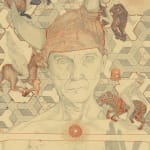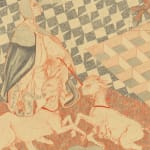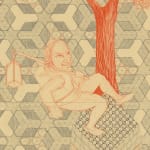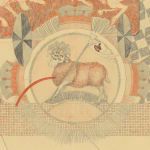

Peter Depelchin,detail from The Great God Pan, 2020

Peter Depelchin,detail from The Great God Pan, 2020

Installation view of 'The Great God Pan' by Peter Depelchin at Husk Gallery

Peter Depelchin,detail from The Great God Pan, 2020

Peter Depelchin,detail from The Great God Pan, 2020

Peter Depelchin,detail from The Great God Pan, 2020
Peter Depelchin
Further images
Visualisation
"The Great God Pan" borrowed its title from the 19th century novella by the hand of Arthur Machen. During a trip to Oxford (England), Depelchin bought a compilation of short stories by Machen. The melancholic Welsch landscape, where Arthur Machen grew up, and its ancient Roman ruins, proved fertile for the writer to add an ancient, chthonic side to his short horror stories. In the short story "The Great God Pan", a scientific, neurologic experiment is executed to evoke the mental state of excitement described as "seeing the God Pan". The short story contains both mythology and psychology, hence undoubtedly inspiring Peter to develop this monumental artwork.
Depelchin's artwork in general, is already known for its abundant presence of ancient mythological and art-historical references. On the one hand, it is this dark, chthonic atmosphere and on the other hand, a psychological reflection on the human condition, Depelchin wishes to integrate and he succeeds well.
Moreover, Depelchin considers this dark side as inherent to the human condition. "The Great God Pan" expresses our psychological condition in two ways: Firstly, because it provides us a portrait of a fragile aging man wearing horns as reference to satyrs, fauns, Pan and in Christian tradition, the devil. Besides, the portrait is watching us and almost acts as a self-reflection in the mirror. Secondly, behind the figure, the drawing shows us a circular sliced composition, consisting of architectural distorted forms borrowed from Persian miniature and Italian panel paintings from the 13th century, and an immense number of small sleeping, dead and lovemaking figures alternated with grotesque narrative scenes and Christian and pagan art historical iconography. These scenes evoke thoughts, streams of consciousness, longings and fear in the same fragmented and oneiric way they occur to us.
At the origin of the creation of such an ambitious piece of art lies Giovanni da Modena. In 2014 Depelchin lived in Rome for a while and one of his trips brought him to Bologna. The biggest cathedral of Bologna, San Petronio, is famous for its huge fresco "Inferno", by the hand of Giovanni da Modena. One of Peter's studies, being featured in this show, presents Depelchin's direct personal interpretation of da Modena's "Inferno". You'll see that he used the composition of the fresco as a blueprint for both the study and the drawing "The Great God Pan". Initially Peter was launched to create a more traditional and almost moralizing reconstruction of da Modena's inferno which is clearly visible in all three of his studies, but six years long his ideas and composition could mature with a contemporary "The Great God Pan" standing.
But the value of this work is really in the juxtaposition of several layers of meaning. This text already mentioned the literary, mythological and psychological layers introduced into this piece. The piece is next to "Columbina", also a witness of Peter's interest for cutting edge theories considering astrophysics. Obviously, there is the black hole represented on the exact location of the belly button of the central figure. Its position is not accidentally: The belly button is the scar witnessing of the exact trajectory through which life was given to each of us. A black hole, on the other hand, can be supermassive, it can be intermediate, but it can also be stellar. Especially for this last type, it means black holes are scars of stars and thus of life. In short, life and dead are omnipresent in this drawing: the trees, the scalps of the goats, the bodies making love and dying, the satyr releasing strange kinds of birds, the female satyr nourishing etc. Moreover, the central figure carrying a ring attached to the nose of the warthog and the feather tickling the anus of a panther could eventually lead the spectator to even further astrophysical interpretation.
Depelchin clearly manifests himself as a demiurge in this drawing. "The Great God Pan" is stuffed with meaning and unveiling all of it, would only suppress appetite.
- X
- Tumblr








